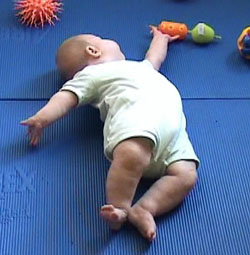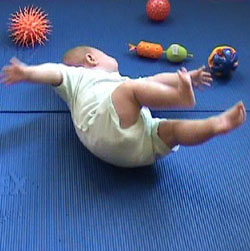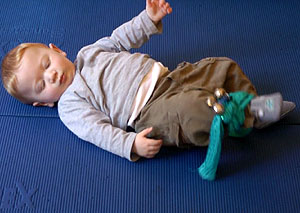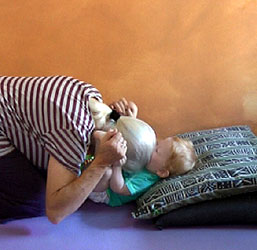Active infants usually learn to roll from their back onto their tummies at around 6-8 months.
Infants who were born prematurely and those with hypermobility tend to lie with their arms and legs flat on the mattress and often develop tightness in the hip and shoulder muscles. They may also be less active kickers and do not develop the strength needed for lifting their legs and heads to initiate rolling.
Some infants only learn to roll onto their tummies as late as 10-12 months after they have learned to sit. Often these infants start to roll onto their sides by arching the back and extending their legs and somehow cannot figure out what to do next. They may have difficulty lifting their heads up when lying on their backs.
Infants need to figure out how to roll
Rolling is a very complex action involving the coordination of head, trunk, arm and legs.
These pictures show Roan aged 7 months figuring out how to get from her back onto her side to reach a toy. Her first response is to arch her back and extend her legs as she tries to reach a toy.


She then discovers that if she bends her leg she topples over onto her side.
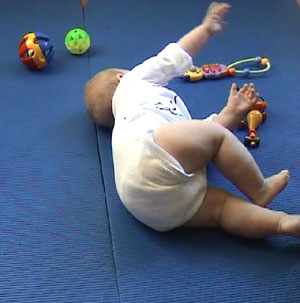
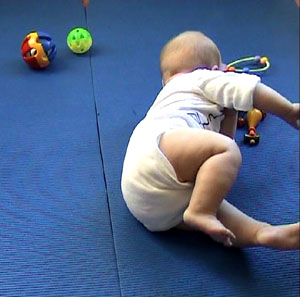
She kicks her legs and once again looses her balance and topples back onto her back.
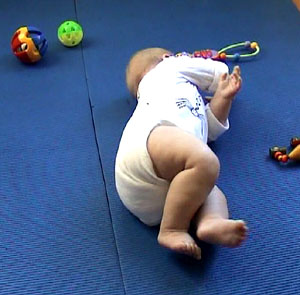
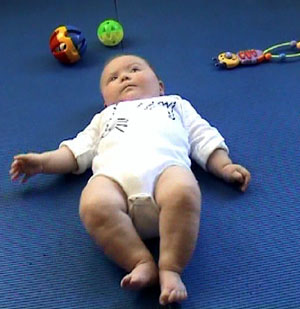
Two weeks later she gets right over onto her tummy
After lots of time spent lying on a nice soft but firm surface and many attempts to reach for toys placed above her head, Roan has learned to control the leg bending and toppling over onto her side and also manages to get onto her tummy.
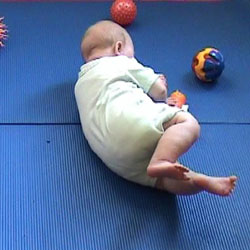
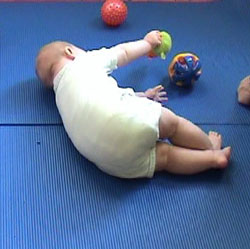

Practice lifting the legs and toppling to the side
Let your infant lie with her buttocks on a pillow so that it is easy for her to pick up both her legs in the air. In this position she is less stable and more likely to topple over to the side.
Play foot games to encourage her to kick her legs and get her trunk muscles working to hold the position.
In these pictures you see Toesies with a beanbag under his buttocks. But this does not have the desired effect and he continues to push down on his feet and lift his buttocks up in the air.
So I tied a bell onto his one leg and this got him lifting his legs to get hold of the cloth I used to secure the bell.


Back flat on the floor, Toesies continues to play with the scarf, and as I had hoped, all the kicking made him loose his balance and topple over onto his side several times. This was a good start at getting him to bend his legs when lying on his back rather than always arching his back.


Sitting up from lying on a pile of cushions
Practicing sitting up from lying on a pile of cushions is another way to get an infant to start lifting the head and shoulders when lying on the back. You can make the pile of pillows higher or lower - see what works best.
Here you see Toesies lying with the head and shoulders raised on a couple of cushions. He is complaining about being in this position and pushing back with his legs in his usual fashion which makes him slide down the pillows and I have to lift him back onto the pillows many times.
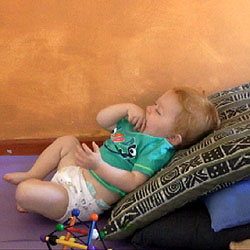

To get him to enjoy this new position I play kissing-your-tummy games.
Push-you-over games
I introduce the push you over game. I help Toesies to sit up, then gently push him over so that he falls back onto the pillows. Then I help him up again. He does not really like this game much to start with and half laughs and half complains.and does lots of pushing back and lifting his buttocks and occasionally lifts up his legs.
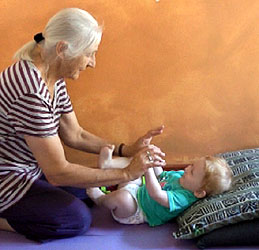
I also tip him backwards by lifting his legs up. Now Toesies is starting to enjoy the game and squeals with delight.

But I persist and after a while he starts to anticipate being pushed and falls over by himself and squeels with delight when he fall over.

After he has gotten the idea of sitting up again, he starts to roll slightly to the side and lifts himself back up to sitting. Hooray he has learned that he can do this!
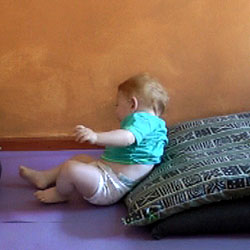

The next time he first lifts up his buttocks and then to my surprise lifts up his head and sits up forwards.



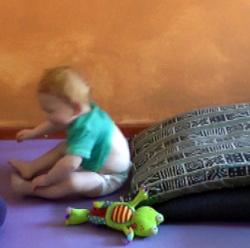
Remember you need to invest time and be patient
The tipping over and sitting up again play session lasted a good twenty minutes. Getting the idea and then working on a new skills takes lots of practice. Active infants are active all their waking hours - they get lots and lots of practice. Less active infants need encouragement and motivation to move. But once they get the idea, well then you cannot stop them either.
